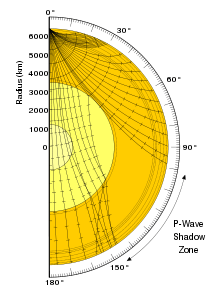Shadow zone

| Part of a series on |
| Earthquakes |
|---|
| Types |
|
|
| Causes |
| Characteristics |
|
|
| Measurement |
| Prediction |
|
|
| Other topics |
|
Earth Sciences Portal Category • Related topics |
A seismic shadow zone is an area of the Earth's surface where seismographs cannot detect an earthquake after its seismic waves have passed through the Earth. When an earthquake occurs, seismic waves radiate out spherically from the earthquake's focus. The primary seismic waves are refracted by the liquid outer core of the Earth and are not detected between 104° and 140° (between approximately 11,570 and 15,570 km or 7,190 and 9,670 mi) from the epicenter. The secondary seismic waves cannot pass through the liquid outer core and are not detected more than 104° (approximately 11,570 km or 7,190 mi) from the epicenter.[1][2] P waves that have been converted to s-waves on leaving the outer core may be detected beyond 140 degrees.
The reason for this is that the velocity for P-waves and S-waves is governed by both the different properties in the material which they travel through and the different mathematical relationships they share in each case. The three properties are: incompressibility ( ), density (
), density ( ) and rigidity (
) and rigidity ( ). P-wave velocity is equal to
). P-wave velocity is equal to  whereas S-wave velocity is equal to
whereas S-wave velocity is equal to  and so S-wave velocity is entirely dependent on the rigidity of the material it travels through. Liquids, however, have zero rigidity, hence always making the S-wave velocity overall zero and as such S-waves lose all velocity when travelling through a liquid. P-waves, however, are only partially dependent on rigidity and as such still maintain some velocity (if greatly reduced) when travelling through a liquid.[3] Analysis of the seismology of various recorded earthquakes and their shadow zones, led geologist Richard Oldham to deduce in 1906 the liquid nature of the Earth's outer core.[4]
and so S-wave velocity is entirely dependent on the rigidity of the material it travels through. Liquids, however, have zero rigidity, hence always making the S-wave velocity overall zero and as such S-waves lose all velocity when travelling through a liquid. P-waves, however, are only partially dependent on rigidity and as such still maintain some velocity (if greatly reduced) when travelling through a liquid.[3] Analysis of the seismology of various recorded earthquakes and their shadow zones, led geologist Richard Oldham to deduce in 1906 the liquid nature of the Earth's outer core.[4]
See also
References
- ↑ "Earthquake Glossary - shadow zone". USGS. Retrieved May 8, 2011.
- ↑ "PX266 Geophysics - Extra Material - Seismic shadow zones". University of Warwick. Retrieved May 8, 2011.
- ↑ Armstrong, D.; Mugglestone, F.; Richards, R.; Stratton, F. (2008). "OCR AS and A2 Geology". Pearson Education: 14.
- ↑ Bragg, William (1936). "Tribute to Deceased Fellows of the Royal Society". Science (American Association for the Advancement of Science) 84 (2190): 544. Bibcode:1936Sci....84..539B. doi:10.1126/science.84.2190.539. ISSN 0036-8075. PMID 17834950.